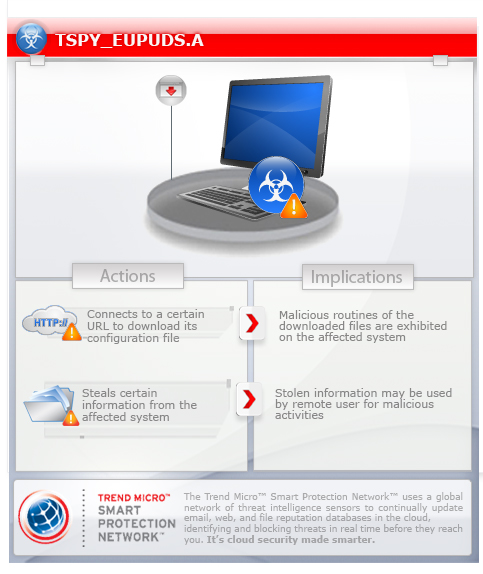TSPY_EUPUDS.A
Trojan-Dropper.Win32.Injector.jsuq, Trojan.Autoit.F (VBA32)
Windows 2000, Windows Server 2003, Windows XP (32-bit, 64-bit), Windows Vista (32-bit, 64-bit), Windows 7 (32-bit, 64-bit)


Threat Type: Spyware
Destructiveness: No
Encrypted: Yes
In the wild: Yes
OVERVIEW
Downloaded from the Internet
This malware uses an AutoIT packer, a scripting language leveraged by cybercriminals. When executed, it steals system-related information and gathers stored user names and passwords from certain browsers.
To get a one-glance comprehensive view of the behavior of this Spyware, refer to the Threat Diagram shown below.

This spyware may be downloaded by other malware/grayware from remote sites.
It retrieves specific information from the affected system.
TECHNICAL DETAILS
1,080,066 bytes
EXE
AutoIt
Yes
20 Dec 2013
Downloads files, Steals information
Arrival Details
This spyware may be downloaded by the following malware/grayware from remote sites:
- TROJ_BANLOAD.LNA
It may be downloaded from the following remote sites:
- http://www.{BLOCKED}d.com/download/p6SLJ1nC/id3.zip
Installation
This spyware drops the following files:
- %Application Data%\25f5093e
- %Application Data%\7c71538a
(Note: %Application Data% is the current user's Application Data folder, which is usually C:\Documents and Settings\{user name}\Application Data on Windows 2000, XP, and Server 2003, or C:\Users\{user name}\AppData\Roaming on Windows Vista and 7.)
It drops the following copies of itself into the affected system:
- %Application Data%\{random folder}\{random filename}.exe
(Note: %Application Data% is the current user's Application Data folder, which is usually C:\Documents and Settings\{user name}\Application Data on Windows 2000, XP, and Server 2003, or C:\Users\{user name}\AppData\Roaming on Windows Vista and 7.)
It creates the following folders:
- %Application Data%\{random folder}
(Note: %Application Data% is the current user's Application Data folder, which is usually C:\Documents and Settings\{user name}\Application Data on Windows 2000, XP, and Server 2003, or C:\Users\{user name}\AppData\Roaming on Windows Vista and 7.)
It adds the following mutexes to ensure that only one of its copies runs at any one time:
- DynGateInstanceMutexS
Autostart Technique
This spyware adds the following registry entries to enable its automatic execution at every system startup:
HKEY_CURRENT_USER\Software\Microsoft\
Windows\CurrentVersion\Run
{random filename} = "%Application Data%\{random folder}\{random filename}.exe"
Download Routine
This spyware connects to the following URL(s) to download its configuration file:
- {BLOCKED}.{BLOCKED}.25.190/mfb.php - inaccessible
Information Theft
This spyware retrieves the following information from the affected system:
- UserID
- Browser & Version
- OS Type and Version
- Malware Version
It attempts to get stored information such as user names, passwords, and hostnames from the following browsers:
- iexplore.exe
- chrome.exe
- firefox.exe
Stolen Information
This spyware sends the gathered information via HTTP POST to the following URL:
- {BLOCKED}.102.{BLOCKED}.190/index.php
NOTES:
It injects its code to a running process except the following:
- Services.exe
- Explorer.exe
- Userinit.exe
- Iexplore.exe
- Firefox.exe
- Chrome.exe
- Crsss.exe
- Svchost.exe
- Winlogon.exe
- Lsass.exe
It hooks ExitProcess API with an infinite sleep command to avoid unloading of memory of process to dump.
It sleeps for 21,000 seconds when there's a running AvastSvc.exe application.
It needs another plugin/component gforce_dll for its URL spoofing for the following websites:
- hotmail.com
- facebook.com
- live.com
SOLUTION
9.700
10.486.01
20 Dec 2013
10.487.00
22 Dec 2013
Step 1
Before doing any scans, Windows XP, Windows Vista, and Windows 7 users must disable System Restore to allow full scanning of their computers.
Step 2
Remove malware/grayware files that dropped/downloaded TSPY_EUPUDS.A
-
TROJ_BANLOAD.LNA
Step 3
Scan your computer with your Trend Micro product and note files detected as TSPY_EUPUDS.A
Step 4
Restart in Safe Mode
Step 5
Delete this registry value
Important: Editing the Windows Registry incorrectly can lead to irreversible system malfunction. Please do this step only if you know how or you can ask assistance from your system administrator. Else, check this Microsoft article first before modifying your computer's registry.
- In HKEY_CURRENT_USER\Software\Microsoft\Windows\CurrentVersion\Run
- {random filename} = "%Application Data%\{random folder}\{random filename}.exe"
- {random filename} = "%Application Data%\{random folder}\{random filename}.exe"
Step 6
Search and delete these folders
- %Application Data%\{random folder}
Step 7
Search and delete this file
- %Application Data%\25f5093e
- %Application Data%\7c71538a
Step 8
Restart in normal mode and scan your computer with your Trend Micro product for files detected as TSPY_EUPUDS.A. If the detected files have already been cleaned, deleted, or quarantined by your Trend Micro product, no further step is required. You may opt to simply delete the quarantined files. Please check this Knowledge Base page for more information.
Did this description help? Tell us how we did.


